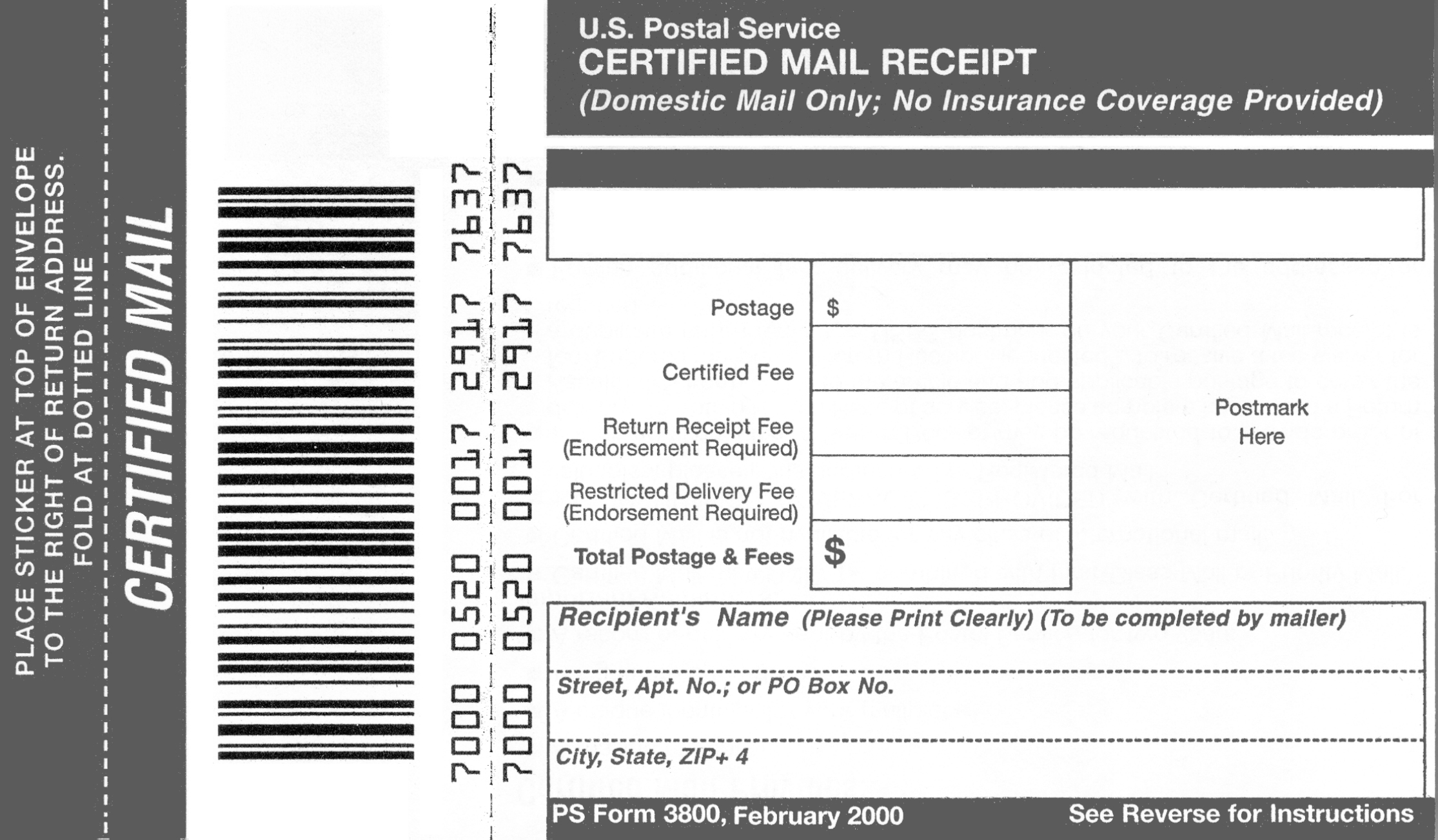 |
 |
S900 Special Postal Services
S910 Security and Accountability
S912 Certified Mail
Summary
S912 describes information and procedures for certified mail, including eligibility requirements, fees and postage, and mailing locations.
1.0 Basic Information
1.1Description
[9-9-04] Certified mail service provides the sender with a mailing receipt and, upon request, electronic verification that an article was delivered or that a delivery attempt was made. Customers can retrieve the delivery status in three ways: (1) over the Internet at www.usps.com by entering the article number shown on the mailing receipt; (2) by telephone at 1-800-222-1811; or (3) by bulk electronic file transfer for mailers who provide an electronic manifest to the Postal Service. Certified mail is dispatched and handled in transit as ordinary mail. Delivery of certified mail is subject to D042. No insurance coverage is provided. The Postal Service maintains a record of delivery (which includes the recipient’s signature) for a specified period of time. Customers may obtain a delivery record by purchasing return receipt service. See S915 for details.
1.2Eligible Matter
Only mailable matter on which postage is paid at a First-Class Mail rate (including Priority Mail) may be accepted as certified mail.
1.3Fee and Postage
The certified mail fee must be paid in addition to the correct postage. The fee and postage may be paid with ordinary postage stamps, meter stamps, or permit imprints. The fee and postage on official mail of federal government agencies and departments are collected under the applicable reimbursement procedures.
1.4Additional Services
Purchasing certified mail service allows customers to then purchase restricted delivery service or a return receipt.
1.5Delivery Record
Mailers may request a delivery record after mailing under S915.
2.0 Mailing
2.1Where to Mail
A mailer may mail certified mail at a post office, branch, or station or give it to a rural carrier. Certified mail may also be deposited in a post office maildrop, a street letterbox, a nonpersonnel unit, or any other receptacle for First-Class Mail, subject to 2.5.
2.2Points to Which Mailable
Certified mail may be addressed for delivery only in the United States and its territories and possessions, through APOs and FPOs, or through the United Nations Post Office, New York.
2.3Form 3800
Certified mail must bear a barcoded green Form 3800 (see Exhibit 2.3). The label part of the form must be placed above the delivery address and to the right of the return address, or to the left of the delivery address on parcels.
2.4Privately Printed Form 3800
If authorized, a mailer may use a privately printed Form 3800. The privately printed form must be nearly identical in design, color, and fluorescent properties to the USPS form with a barcode and human readable numbers that meet the USPS specifications in Publication 109. A minimum of three preproduction samples must be submitted to the business mail entry manager serving the mailer’s location for review by the mailpiece design analyst. Once approved, the mailer must print sample labels with barcodes to be certified under the technical requirements in Publication 109.

2.5Procedure
A mailer of certified mail must:
a. Enter on Form 3800 the name and complete address of the person or firm to whom the mail is addressed.
b. If a return receipt is requested, check the block on the mailing receipt to show the fee. Near the certified mail endorsement on the address side, add the endorsement “Return Receipt Requested.” Enter the certified mail number on the return receipt card, address it to himself or herself, and attach it to the back of a small envelope or on the front of a package or large envelope, if the card does not cover the address. Enter the name and delivery address on the reverse of the return receipt to show where the receipt is to be sent. When a return receipt is requested, a complete return address (sender’s name and delivery address) is required on the mailpiece. The name and delivery address entered on the reverse of the return receipt do not have to match the sender’s name and return address on the mailpiece.
c. Affix to the envelope enough postage to pay for the certified mail fee and First-Class Mail rate and, if requested, the return receipt fee.
d. If a postmarked sender’s receipt is requested, attach the certified mail sticker to the address side of the article and present the article and the completed receipt to the USPS employee, who then round-dates the receipt to show when the article was accepted. If asked to do so, the USPS employee also shows on the receipt the time the article was accepted. Otherwise, attach the “certified mail” sticker to the address side of the article, detach the receipt, and mail the article. Mark the receipt to show the date.
e. If restricted delivery of certified mail to the addressee or someone named by the addressee in writing is requested, endorse the mail “Restricted Delivery.” This service is available only for articles addressed to individuals by name.
2.6Firm Sheet
If three or more certified articles are presented for mailing at one time, the mailer may use Form 3877 (firm sheet) or privately printed firm sheets. Privately printed or computer-generated sheets that contain the same information as Form 3877 may be approved by the local postmaster. The mailer may omit columns from Form 3877 that are not applicable to certified mail. If the mailer wants the firm sheets receipted by the USPS, the mailer must present the books with the articles to be mailed at a post office. The sheets of the books become the mailer’s receipts. All entries made in firm sheets must be made by typewriter, ink, or ballpoint pen. Alterations must be initialed by the mailer and accepting employee. All unused portions of the addressee column must be obliterated with a diagonal line.
DMM Issue 58 Updated 12-9-04